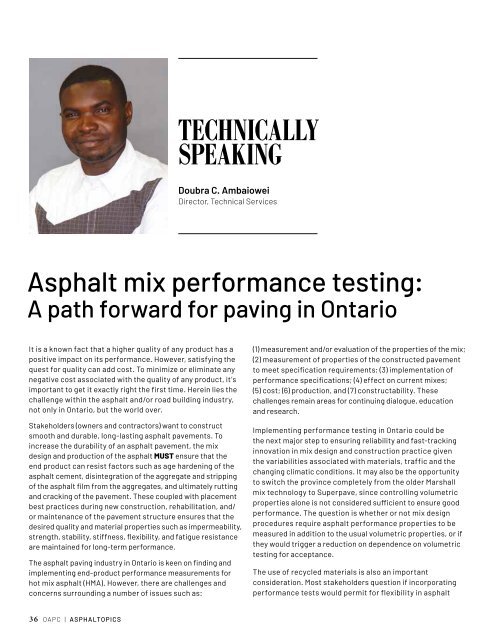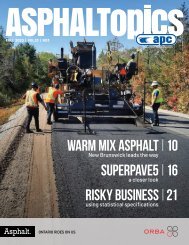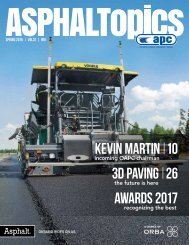ASPHALTopics | Summer 2021 | VOL 34 | NO 2
Create successful ePaper yourself
Turn your PDF publications into a flip-book with our unique Google optimized e-Paper software.
TECHNICALLY<br />
SPEAKING<br />
Doubra C. Ambaiowei<br />
Director, Technical Services<br />
Asphalt mix performance testing:<br />
A path forward for paving in Ontario<br />
It is a known fact that a higher quality of any product has a<br />
positive impact on its performance. However, satisfying the<br />
quest for quality can add cost. To minimize or eliminate any<br />
negative cost associated with the quality of any product, it’s<br />
important to get it exactly right the first time. Herein lies the<br />
challenge within the asphalt and/or road building industry,<br />
not only in Ontario, but the world over.<br />
Stakeholders (owners and contractors) want to construct<br />
smooth and durable, long-lasting asphalt pavements. To<br />
increase the durability of an asphalt pavement, the mix<br />
design and production of the asphalt MUST ensure that the<br />
end product can resist factors such as age hardening of the<br />
asphalt cement, disintegration of the aggregate and stripping<br />
of the asphalt film from the aggregates, and ultimately rutting<br />
and cracking of the pavement. These coupled with placement<br />
best practices during new construction, rehabilitation, and/<br />
or maintenance of the pavement structure ensures that the<br />
desired quality and material properties such as impermeability,<br />
strength, stability, stiffness, flexibility, and fatigue resistance<br />
are maintained for long-term performance.<br />
The asphalt paving industry in Ontario is keen on finding and<br />
implementing end-product performance measurements for<br />
hot mix asphalt (HMA). However, there are challenges and<br />
concerns surrounding a number of issues such as:<br />
(1) measurement and/or evaluation of the properties of the mix;<br />
(2) measurement of properties of the constructed pavement<br />
to meet specification requirements; (3) implementation of<br />
performance specifications; (4) effect on current mixes;<br />
(5) cost; (6) production, and (7) constructability. These<br />
challenges remain areas for continuing dialogue, education<br />
and research.<br />
Implementing performance testing in Ontario could be<br />
the next major step to ensuring reliability and fast-tracking<br />
innovation in mix design and construction practice given<br />
the variabilities associated with materials, traffic and the<br />
changing climatic conditions. It may also be the opportunity<br />
to switch the province completely from the older Marshall<br />
mix technology to Superpave, since controlling volumetric<br />
properties alone is not considered sufficient to ensure good<br />
performance. The question is whether or not mix design<br />
procedures require asphalt performance properties to be<br />
measured in addition to the usual volumetric properties, or if<br />
they would trigger a reduction on dependence on volumetric<br />
testing for acceptance.<br />
The use of recycled materials is also an important<br />
consideration. Most stakeholders question if incorporating<br />
performance tests would permit for flexibility in asphalt<br />
36 OAPC | ASPHALTOPICS

















